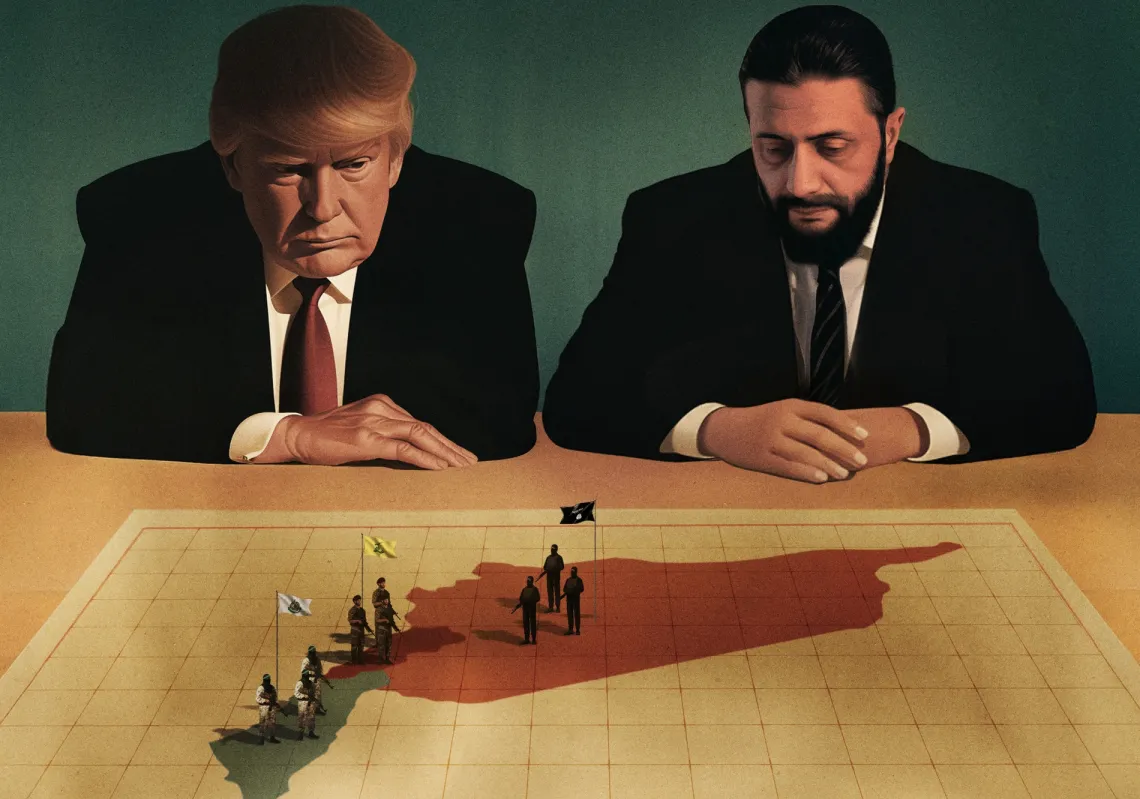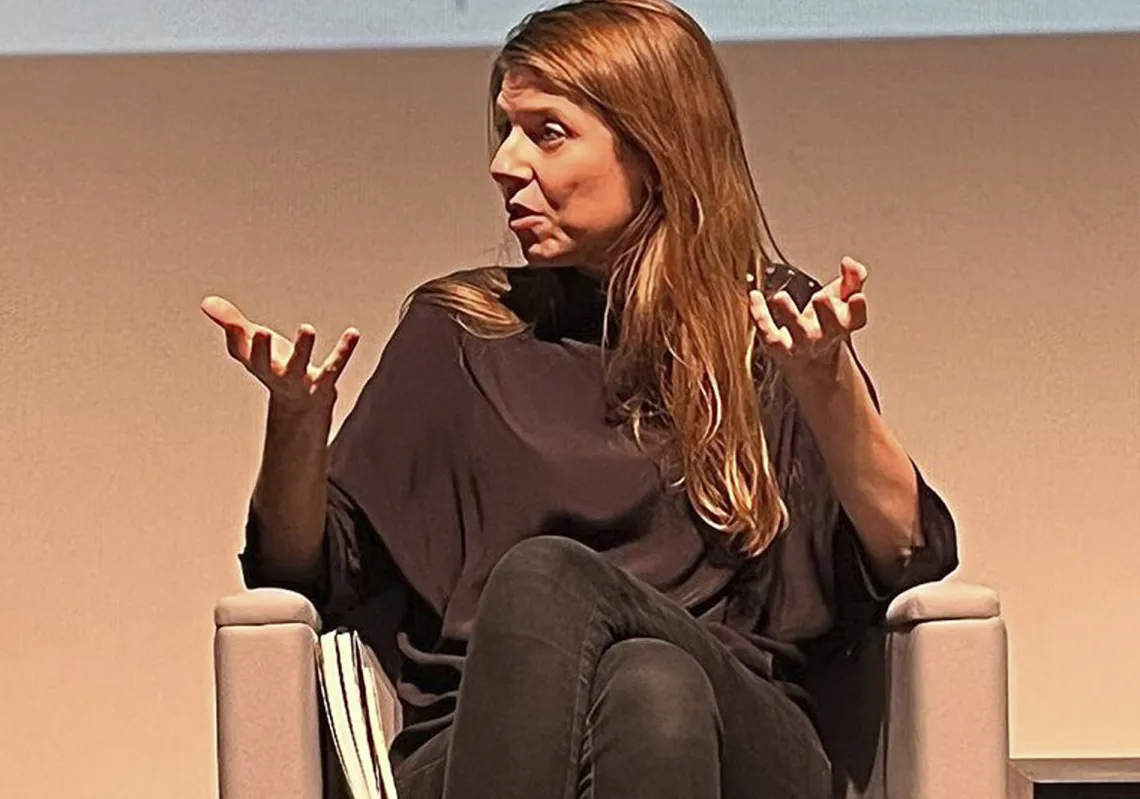From studios in the Arab world and beyond, Al Majalla offers thoughtful critiques of the newest films to hit the screen, from mainstream blockbusters and art-house entries.
Nosferatu
Screenplay & Direction: Robert Eggers
Country: United States
This 2024 film opens with scenes of lamentation and prayer by a grief-stricken Ellen (Lily-Rose Depp), yet it is not God who answers her pleas, but Nosferatu. He personifies the forces of darkness—opening doors, docking ships, and spreading the plague. “He is death itself,” characters whisper of this deformed, demonic creature.
The director was deeply inspired by the classic German expressionist film of the same name and weaves elements from the original tale—an adaptation of Bram Stoker’s Dracula—with the conventions of traditional American horror, including possessed bodies and horrified church officials.
The witty and vibrant Willem Dafoe plays Dr Franz, a scientist specialising in the occult who argues that science has “blinded our insight”. Eggers sets up a Faustian bargain—a soul-selling pact with the devil—with dollops of sacrifice and redemption, echoing the Christian symbolism from the original film.
Within the constraints of reimagining a classic, he also explores questions about the nature of evil. For instance: does it come from within, or is it external? How do we prevent our own sorrow and shame from swallowing us up, much like Nosferatu does in Ellen’s life?
As Dr Franz observes, Ellen is driven by animalistic instincts, yet Nosferatu is also portrayed as a punishment for her sinful indulgence in grief, the origins of which remain shrouded in ambiguity.
Despite Eggers’ diligent efforts to fill the narrative gaps left by the 1922 silent classic, there is little truly new on offer here. It remains largely anchored to the original film’s philosophical foundations. There is an evident tension between the ambition to create a film that is both artistic and commercially viable—and of honouring the past.
Still, the director gives his characters backstories and crafts a more cohesive plot, making the new Nosferatu a compelling watch. Aesthetically, it preserves key elements of its predecessor, particularly in the composition of certain scenes, skilfully employing shadows to represent human figures—and, of course, Nosferatu himself—whose looming silhouette serves as an ominous symbol of death and loss.
Ultimately, if the new adaptation achieves anything, it is a reaffirmation of the enduring magic of the original—a testament to its timeless power and lasting influence.
Le Comte de Monte-Cristo
Screenplay and Direction: Alexandre de La Patellière, Matthieu Delaporte
Country of Production: France
One of the most successful French films of recent years that is currently nominated in 14 categories at the César Awards, The Count of Monte Cristo (Le Comte de Monte-Cristo) needs no introduction: Alexandre Dumas’ classic novel remains the quintessential reference when discussing the theme of dramatic revenge—an enduring motif explored across world cinema without ever losing its appeal.
Spanning 2,000 pages in its original language, the book holds a special place in French hearts, so the new film adaptation was aiming high with a slice of French national culture. It is not shy of ambition as it seeks to showcase the prowess of French cinema, aiming to rival Hollywood in terms of large-scale spectacle delivery with striking cinematography, intense action, and epic battle sequences.
It also capitalises on France’s historic castles and islands, meaning that it is at least in part a national promotion, offering backdrops to the sweeping political changes that reshaped the country in the early 19th century—a world of aristocracy and bourgeoisie.
In the film, a father poisons his illegitimate child, with the mother complicit, seeking to protect her shared interests with her lover. They also conspire against the lower-class sailor Edmond Dantès (played by Pierre Niney), condemning him to an isolated prison at the bottom of a well on a remote island.
In the process, Edmond loses everything—his beloved Mercédès (played by Anaïs Demoustier), his promising future, and nearly his life. In a symbolic sense, he perishes, giving rise to the persona of the Count of Monte Cristo—a force of vengeance and retribution in a world where true justice remains elusive.
This is a visually captivating experience, harnessing the latest cinematic effects with stunning natural settings and meticulous attention to lighting (important in a world where fire has a big part to play) and make-up (which plays a crucial role in the Count’s elaborate disguises and deceptions), as he carefully executes his plan.
The film asks: how far can revenge go? What can it ultimately achieve for those who seek it? The answers are neither simple nor direct. In the end, The Count of Monte Cristo emerges as a classic tale reimagined through the lens of modern cinematic techniques.
6 Days
Written and Directed by: Wael Hamdy, Karim Shaaban
Country of Production: Egypt
An Egyptian film that has garnered attention, 6 Days is a romantic drama that does not rely on comedy for validation or an audience. Wael Hamdy’s screenplay follows the evolving lives of Alia Burhan (Aya Samaha) and Youssef Rahmi (Ahmed Malek), beginning with their school days, where they share a profound emotional bond that lingers between friendship and love until their connection is severed when a family tragedy strikes Alia’s life, creating an unavoidable rift.
Spanning six days across different years, their sporadic reunions become the film’s central structure. The first happens by chance, reigniting their past connection and contemplating what remains of their relationship. They agree to meet again each year. These meetings become moments of raw honesty and self-revelation.
6 Days is a film driven by dialogue. Viewers trace Alia and Youssef’s journey by listening not just to their words but also to the pauses and to the subtle cues from their body language. Each time they meet, one of them seems to be ‘on the up’, while the other seems caught in a downward spiral. This asymmetry keeps them apart.
The weight of the past looms over them, as does the burden of ill-fated choices. It depicts intergenerational trauma and the idea that first love—with its purity and untainted emotions—may still offer a path to healing in the present.
One of the film’s most distinctive elements is its nostalgic tribute to life in early 2000s Cairo—cassette tapes, cinema, and a world untouched by social media. This enhances the film’s appeal and will resonate with those born in the 1980s and early 1990s. Al-Hawa Sultan, which premiered late last year, similarly captured a yearning for the past, evoking a sense of temporal stillness within the same generation.
Overall, 6 Days could have delved deeper into its characters or expanded beyond the isolation of its two protagonists, yet it remains an engaging and well-received film.
The Lamb
Written and Directed by: Jo Rogers, Ashley Avis
Country of Production: Saudi Arabia
This heartwarming family film draws inspiration from Antoine de Saint-Exupéry’s beloved novella The Little Prince, not least since both stories journey through the untainted eyes of a child. Feisal (Abdulaziz Al-Qahtani) lives with his family in the desert, where they run a livestock farm. He leads us into a tender and poignant exploration of our humanity, defying greed and instead embracing dreams, generosity, and selflessness.
His young life is upended when, aged 8, he loses his mother and finds solace in an orphan lamb from the farm. He names her Shahd, takes her into his care, and forms an unbreakable bond with her, yet his father (Fahad Al-Ghamdi) disapproves of the attachment, insisting that the lamb must return to the herd to grow like the rest of the livestock—whose ultimate fate is the slaughterhouse.
Feisal refuses to part with Shahd, running away from home to evade the trader who has come to collect her. His journey leads him toward Riyadh, the ‘city of dreams’ where his late mother longed to visit. “Any dream can come true in Riyadh,” she told him. Along the way, Feisal faces challenges but meets them with loyalty and a degree of resilience far beyond his tender years.
His journey to Riyadh is a visual journey, passing majestic rock formations, golden-hued sands, and vast salt plains. Along the way, he finds refuge with a Bedouin tribe that vows to help him, offering companionship and support.
Although the story unfolds in the deserts and traditions around the Saudi capital, its themes are universal. It is a tale that could unfold anywhere and beautifully captures the delicate bond between children and animals, with young rising star Abdulaziz Al-Qahtani delivering a standout performance.
His connection with the lamb is striking, as it follows him and calls to him with remarkable authenticity throughout the story. Ultimately, the film reaffirms a timeless truth: just as children learn from adults, so too can adults learn from children.
The Sand Castle
Written and Directed by: Matty Brown, Yassmina Karajah, Hend Fakhroo – Matty Brown
Country of Production: Lebanon
The latest Arabic-language film on Netflix, The Sand Castle, tells the story of a family of four—young Jana (Riman Al-Rafeea), her brother Adam (Zain Al-Rafeea), their mother Yasmine (Nadine Labaki), and their father Nabil (Ziad Bakri)—who live on an island with a lighthouse.
Events unfold through the eyes of Jana, with whom the movie begins and ends. Gathered around the dinner table on a picturesque island in the middle of the sea, the family is not enjoying a life of comfort but rather enduring hardship, the meagre portions on their plates a stark reflection of their dwindling food supply. The vast and ominous sea surrounding them refuses to yield anything edible.
The island lies near Greece, and early in the film, Yasmine listens to a radio broadcast reporting on the sinking of migrant boats. As time goes on, the line between reality and illusion blurs—first for the parents, Yasmine and Nabil, whose prolonged isolation, fear, hunger, and thirst gradually distort their perception.
This is a psychological drama in which the turmoil extends to the children, particularly Jana, who is haunted by memories of losing her younger sister, Yara, during a past war from which the family seemingly fled to reach this island. Nabil believed he could escape his past by leading his family to the sea.
Guilt permeates every aspect of the film. Jana, with a childlike innocence, carries the unbearable weight of believing she abandoned her sister, thus causing her death. The family shoulders an emotional burden that should belong to the instigators of war—those who, had they taken responsibility, might have spared innocent lives.
This film ultimately proves short of answers. Did Nabil take his family to the island as a temporary refuge, hoping for a way to reach the Greek shores, or is there no island, and in fact, the family perished at sea like the countless others whose lifeless bodies Jana glimpses? Whatever else, the Sand Castle is a harrowing, deeply unsettling, and profoundly sorrowful film.
Nosferatu: A Symphony of Horror (1922)
Screenplay and Direction: Henrik Galeen, F.W. Murnau
Country of Production: Germany
It is said that Nosferatu’s producer, Albin Grau, was a member of secret societies with a deep fascination with the occult. This reportedly fuelled his enthusiasm for making this film from the archives, incorporating mystical symbols and incantations drawn from his esoteric knowledge.
In the late 19th and early 20th centuries, cinema was still in its infancy, while Bram Stoker’s Dracula continued to gain widespread popularity—even after the author’s death—through its chilling portrayal of a vampire dwelling in a secluded castle, preying upon women.
Grau may have seen in the novel a foundation for his vision, but Nosferatu (as it appears in this silent film) ultimately became an entity distinct from Stoker’s vampire. He is pure evil—yet not an evil born of human corruption, but a force of nature, descending upon the people of Wisborg like the plague.
Believing that a loose adaptation of the novel allowed him to bypass legal constraints regarding intellectual property, Grau proceeded with the film without obtaining permission from Stoker’s estate, but the author’s widow successfully sued him, and a court ordered all copies of the film to be destroyed.
Had it not been for some who circumvented the law, Nosferatu might have been lost forever. It is now one of the masterpieces of the German expressionist school, whose pioneers rejected the notion that cinema should strictly adhere to reality.
Instead, they believed it should construct its own worlds, free from the constraints of realism. This movement reflects the fear, anxiety, and fragmentation of humanity in a world shattered by war, where certainty and truth no longer exist.
In one interpretation, Nosferatu can be read as an attempt to explain the spread of the Spanish flu epidemic and the immense loss of life it caused. In another, it foreshadows the rise of Nazism, the scapegoating of Jews for Germany’s World War I defeat and economic collapse, and the horrors of the Holocaust that followed.
Visually, the film captivates with its striking Gothic architecture. The camera is sensitive to nature and moves at unnerving speed in certain scenes—heightening the demonic, superhuman essence of Nosferatu as the messenger of death. Physically, the vampire in Nosferatu is closer to a sinister figure than a deformed human with long fangs, as Hollywood would later portray him. Yet his shadow looms unnaturally large, stretching across the world as an omen of destruction.
The film has several unforgettable scenes. One is Nosferatu’s eerie ability to move his coffins with an invisible force, witnessed through the terrified gaze of Thomas Hutter from the castle window. Another is Hutter’s arrival at the vampire’s lair, riding in a horse-drawn carriage as an unseen hand opens the massive castle doors. Another is the chilling moment Hutter cuts his finger, triggering Nosferatu’s predatory hunger.
It is essential to remember that this film emerged at the dawn of cinema itself. In 1979, German director Werner Herzog reimagined Nosferatu, infusing the vampire with a depth of humanity—emphasising his loneliness and longing for love. Even the newest adaptations of Nosferatu serve as a testament to the enduring power of this silent classic, an inexhaustible well of inspiration for filmmakers everywhere.












